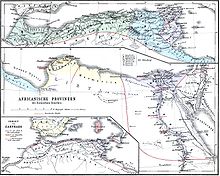|
Myos Hormos
Myos Hormos (Ancient Greek: Μυὸς Ὅρμος) was a Red Sea port founded by the Ptolemy II Philadelphus upon a headland of similar name, around the 3rd century BC.[1] Later, it was renamed to Aphrodites Hormos (Ancient Greek: Ἀφροδίτης ὅρμος) but the elder appellation is more generally retained.[1] Following excavations carried out recently by David Peacock and Lucy Blue of the University of Southampton, it is thought to have been located on the present-day site of Quseir al-Quadim (old Quseir), eight kilometres north of the modern town of El Qoseir in Egypt.[2] EtymologyThe Myos Hormos may mean the "Harbour of the Mouse", but most probably meant the "Harbour of the Mussel" (μύειν, to close, e.g. the shell), since on the neighbouring coast the pearl mussel was collected in large quantities.[1][3] Also, it seems to have obtained the name of Aphrodite (technically meaning foam of the sea), from the abundance of sea-sponge found in its bay.[1] HistoryPtolemy II Philadelphus selected it for the principal harbour of the trade with India, in preference to Arsinoe, since Arsinoe was at the head of the Red Sea and there was a tedious and difficult navigation down the Heroopolite Gulf. Vessels from Myos Hormos traded with Africa, Arabia, and India.[1]
After the Ptolemies, it was with Berenice (further south on the Red Sea coast) one of the two main ports in Roman Egypt for trade with India, Africa and probably China.[7] Some of its main destinations were the Indus delta, Muziris and the Kathiawar peninsula in India. The coastal trade from Myos Hormos and Berenice along the coast of the Indian Ocean is described in the anonymous 1st century AD handbook Periplus of the Erythraean Sea.
It was one of the main trading centers on the Red Sea.[9] According to Strabo (II.5.12), by the time of Augustus, up to 120 ships were setting sail every year from Myos Hormos to India:
The port of Myos Hormos was connected to the Nile valley and Memphis by a Roman road, built in the 1st century. After the 4th century the port was abandoned, because of the Roman Empire crisis and the end of the trade between Rome and India. Only in the 17th century the port started to regain some importance, mainly because of holy travel from Cairo to Mecca. Myos Hormos is now the city of old Qusair.[10]  References
Bibliography
External linksSee also |
||||||||||||||||||||||||||||||||||||||||

